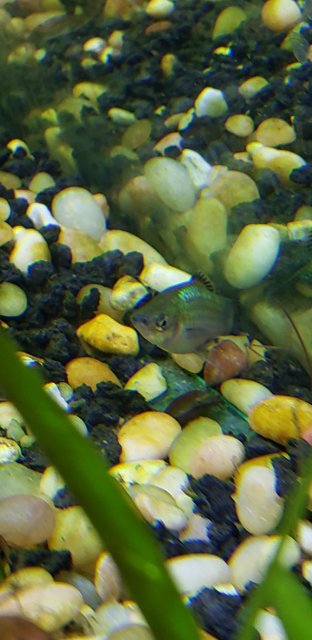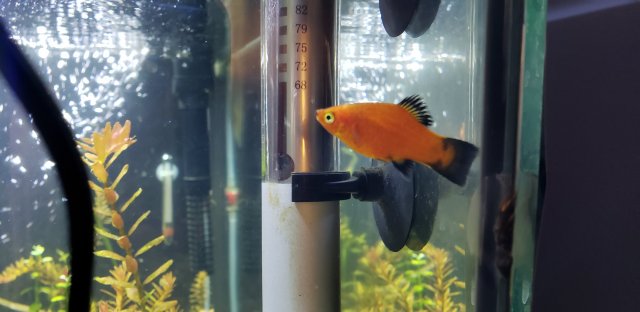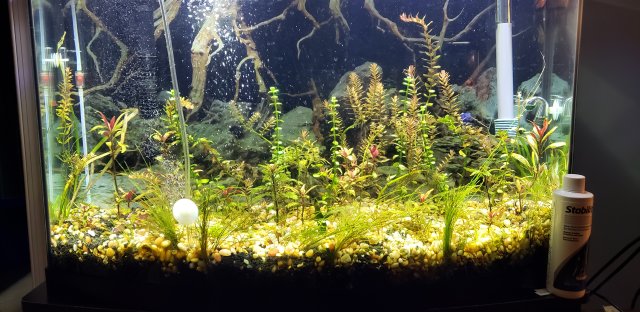A bit of back story, I purchased this (36 gallon bowfront) tank used from someone selling it on facebook. It was previously used as an aquarium, not for a reptile or anything like that. I thoroughly cleaned the tank with boiling water and a (new) sponge. I took the filter apart and cleaned it as well as soaking it in boiling water. There was aquarium sand in the tank when I first purchased it. I set the tank up and cycled it for approximately 6 weeks. I used filter media from another tank I have and put plants in there. After about a month, I changed out the substrate, thinking maybe it could have been something with the sand.
Introduction of fish at the beginning of April, I purchased 2 dalmatian mollies and 2 algae eaters from a big box pet store. One of the mollies died within a few days. The other molly seemed very stressed after the death of its tankmate, so I moved it into my 20 gallon with 2 platys and a lyretail molly (not the smartest move, I know). The dalmatian molly is still alive and well today. Soon after the death of the first molly, the 2 algae eaters died, leaving the tank empty. None of the fish (other than the molly I moved to another tank) survived longer than 2 weeks and none of them have lived any longer than that since. I test my water religiously and had the water tested at both big box pet stores as well as a local fish store. Every time the water has been tested, all the levels have been ideal. The only slight level variation was the pH was elevated (8.4). I used Seachem Neutral regulator for a few days until the levels returned to normal.
I am at my wits end and am devastated to be losing so many fish. I should note that I have 2 other tanks, a 20 gallon planted tank and a 10 gallon tank. I use the same water source and same chemicals in all 3 tanks. All of the plants I have ordered have been split between the 36 gallon and the 20 gallon. I have never run into an issue like this and I am hoping I can get some help. I was having this problem with the fish dying before and after the introduction of co2.
1. Size of tank?
36 gallon bowfront
2. Parameters (Tetra EasyStrips 6 in 1)
Nitrate: 0
Nitrite: 0
GH: 75
Chlorine: 0
Total Alkalinity: 180
pH: 7.8
3. Temperature?
- 77°F
4. FW (fresh water) or BW (brackish)?
- Freshwater
5. How long the aquarium has been set up?
Set the tank up in the beginning of February, first introduced fish in early April.
6. What fish do you have? How many are in your tank? How big are they? How long have you had them?
Sadly, I have probably gone through about 20 fish in this tank ranging from tiger barbs, mollies, platys, bristlenose plecos, red eye tetras, cherry barbs, debauwi catfish, algae eaters and black skirt tetras. Right now, the only two living fish are 2 platys about 1.5 inches long.
7. Were the fish placed under quarantine period (minus the first batch from the point wherein the tank is ready to accommodate the inhabitants)?
The fish were never placed in quarantine because the tank was empty each time I added a new group.
8. a. Live plants:
-creeping charlie
-Bacopa Monnieri
- Alternathera Rosanervig
-Micro sword
-Red Tiger Lotus
- Rotala Rodundifolia Red
- Dwarf Hairgrass
- Rotala Walichii
- Amazon Sword
-Java Fern
-Hygrophila Pinnatifida
b. Sand, gravel, barebottom?
-started with sand
then changed to:
- Carib sea eco complete with gravel on top
c. Rocks, woods, fancy decors? Any hollow decors?
no decor
d. additional equipment
-infused co2 (5lb tank)
-pH drop checker
-14 inch bubbler bar
9. a. Filtration?
- Top Fin silentstream 40. I will usually rinse and reuse the filter with each water change in the siphoned tank water.
b. Heater?
-200 w heater
10. a. Lighting schedule? What lights are used?
- 11am - 10pm
- The light is a Beamswork DA 6500k
b. Any sunlight exposure? How long?
-very little if any
11. a. Water change schedule?
-Every 2 weeks, most recent being Thursday (June 11th)
b. Volume of water changed?
-~20-25% (about 8 gallons)
c. Frequency of gravel/sand (if any) vacuumed?
- spot vacuum once a month
12. Foods?
- frozen brine shrimp
How often are they fed?
-nightly, a very small piece typically consumed in under 5 minutes
13. a. Any abnormal signs/symptoms?
-The fish will be fine and swimming happily soon after they are in the tank. There is no consistency with their survival rate. Some last less than one day, others will last a couple of weeks. Some of the fish will be just fine when I leave for work, and by the time I get home 9 hours later, they are dead at the bottom of the tank. Some will start surfacing to get air then begin swimming listlessly and end up laying at the bottom of the tank barely breathing, sometimes even getting stuck on the filter intake.
b. Appearance of poop?
- Long green strings
c. Appearance of gills?
-Gills look fine, no spots or flaking
14. a. Have you treated your fish ahead of diagnosis?
-I have treated the water, not the fish. I will use a dose of paragard when I initially add fish to the tank.
b. What meds were used?
- No meds, but with each water change, I will dose the tank with Seachem stability and Seachem Neutral Regulator. Weekly dose of Seachem Flourish
15. Insert photos of fish in question and full tank shot if necessary.



Introduction of fish at the beginning of April, I purchased 2 dalmatian mollies and 2 algae eaters from a big box pet store. One of the mollies died within a few days. The other molly seemed very stressed after the death of its tankmate, so I moved it into my 20 gallon with 2 platys and a lyretail molly (not the smartest move, I know). The dalmatian molly is still alive and well today. Soon after the death of the first molly, the 2 algae eaters died, leaving the tank empty. None of the fish (other than the molly I moved to another tank) survived longer than 2 weeks and none of them have lived any longer than that since. I test my water religiously and had the water tested at both big box pet stores as well as a local fish store. Every time the water has been tested, all the levels have been ideal. The only slight level variation was the pH was elevated (8.4). I used Seachem Neutral regulator for a few days until the levels returned to normal.
I am at my wits end and am devastated to be losing so many fish. I should note that I have 2 other tanks, a 20 gallon planted tank and a 10 gallon tank. I use the same water source and same chemicals in all 3 tanks. All of the plants I have ordered have been split between the 36 gallon and the 20 gallon. I have never run into an issue like this and I am hoping I can get some help. I was having this problem with the fish dying before and after the introduction of co2.
1. Size of tank?
36 gallon bowfront
2. Parameters (Tetra EasyStrips 6 in 1)
Nitrate: 0
Nitrite: 0
GH: 75
Chlorine: 0
Total Alkalinity: 180
pH: 7.8
3. Temperature?
- 77°F
4. FW (fresh water) or BW (brackish)?
- Freshwater
5. How long the aquarium has been set up?
Set the tank up in the beginning of February, first introduced fish in early April.
6. What fish do you have? How many are in your tank? How big are they? How long have you had them?
Sadly, I have probably gone through about 20 fish in this tank ranging from tiger barbs, mollies, platys, bristlenose plecos, red eye tetras, cherry barbs, debauwi catfish, algae eaters and black skirt tetras. Right now, the only two living fish are 2 platys about 1.5 inches long.
7. Were the fish placed under quarantine period (minus the first batch from the point wherein the tank is ready to accommodate the inhabitants)?
The fish were never placed in quarantine because the tank was empty each time I added a new group.
8. a. Live plants:
-creeping charlie
-Bacopa Monnieri
- Alternathera Rosanervig
-Micro sword
-Red Tiger Lotus
- Rotala Rodundifolia Red
- Dwarf Hairgrass
- Rotala Walichii
- Amazon Sword
-Java Fern
-Hygrophila Pinnatifida
b. Sand, gravel, barebottom?
-started with sand
then changed to:
- Carib sea eco complete with gravel on top
c. Rocks, woods, fancy decors? Any hollow decors?
no decor
d. additional equipment
-infused co2 (5lb tank)
-pH drop checker
-14 inch bubbler bar
9. a. Filtration?
- Top Fin silentstream 40. I will usually rinse and reuse the filter with each water change in the siphoned tank water.
b. Heater?
-200 w heater
10. a. Lighting schedule? What lights are used?
- 11am - 10pm
- The light is a Beamswork DA 6500k
b. Any sunlight exposure? How long?
-very little if any
11. a. Water change schedule?
-Every 2 weeks, most recent being Thursday (June 11th)
b. Volume of water changed?
-~20-25% (about 8 gallons)
c. Frequency of gravel/sand (if any) vacuumed?
- spot vacuum once a month
12. Foods?
- frozen brine shrimp
How often are they fed?
-nightly, a very small piece typically consumed in under 5 minutes
13. a. Any abnormal signs/symptoms?
-The fish will be fine and swimming happily soon after they are in the tank. There is no consistency with their survival rate. Some last less than one day, others will last a couple of weeks. Some of the fish will be just fine when I leave for work, and by the time I get home 9 hours later, they are dead at the bottom of the tank. Some will start surfacing to get air then begin swimming listlessly and end up laying at the bottom of the tank barely breathing, sometimes even getting stuck on the filter intake.
b. Appearance of poop?
- Long green strings
c. Appearance of gills?
-Gills look fine, no spots or flaking
14. a. Have you treated your fish ahead of diagnosis?
-I have treated the water, not the fish. I will use a dose of paragard when I initially add fish to the tank.
b. What meds were used?
- No meds, but with each water change, I will dose the tank with Seachem stability and Seachem Neutral Regulator. Weekly dose of Seachem Flourish
15. Insert photos of fish in question and full tank shot if necessary.





